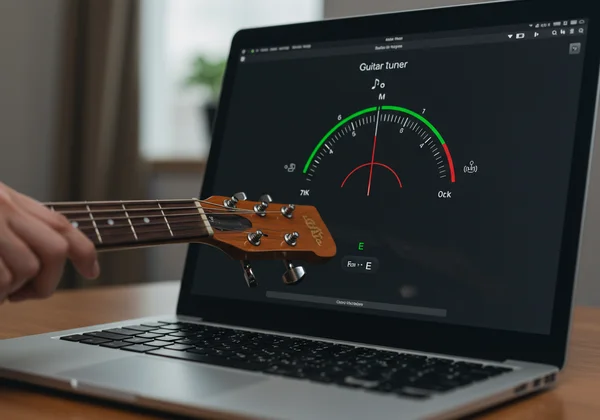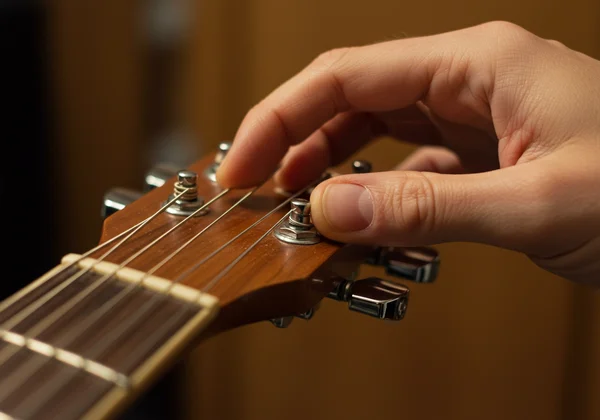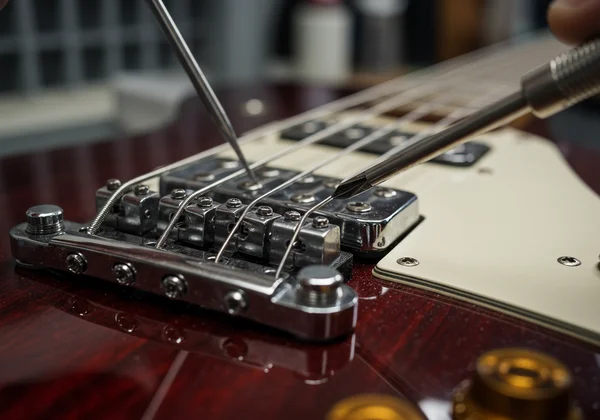Master Guitar Tuning with Our Free Online Tuner: Standard, Drop D & Beyond
An out-of-tune guitar is more than just a minor annoyance; it’s a barrier between you and the music you want to create. Every guitarist, from the bedroom beginner to the stage-touring pro, knows the frustration of hitting a chord that just sounds wrong. The good news is that achieving perfect pitch is easier than ever. So, how to tune a guitar online? This ultimate guide will walk you through every aspect of guitar tuning, from the essential basics to creative alternate tunings, all while showing you how our free online guitar tuner can be your most reliable tool.
Understanding the Fundamentals of Guitar Tuning
Before you can master the art of tuning, it's crucial to understand the fundamentals. Knowing why accurate pitch is important and how standard tuning is structured provides the foundation for every note you'll play. This knowledge empowers you to tune quickly and confidently, ensuring your instrument always sounds its best.
Why Accurate Pitch Matters for Every Guitarist
Accurate pitch is the cornerstone of music. When your guitar is in tune, each note harmonizes correctly with the others, producing the rich, full sound you expect. Playing an out-of-tune instrument can hinder your progress, make practice sessions frustrating, and train your ear to accept incorrect sounds. Whether you're playing solo or with a band, being perfectly in tune is a sign of professionalism and respect for the music.
Standard Guitar Tuning Explained (E-A-D-G-B-e)
The most common tuning for a six-string guitar is known as Standard Tuning. The strings are tuned from thickest (lowest pitch) to thinnest (highest pitch) as follows:
- 6th string (thickest): E (low E)
- 5th string: A
- 4th string: D
- 3rd string: G
- 2nd string: B
- 1st string (thinnest): e (high e)
Memorizing this sequence, often with a mnemonic like "Elephants And Donkeys Grow Big Ears," is the first step for any new guitarist. Our [online instrument tuner] has a preset for standard tuning to make this process foolproof.
How an Online Guitar Tuner Works (The Tech Behind Our Free Online Tuner)
Our online microphone tuner leverages the power of your device's microphone to analyze the sound waves your guitar produces. When you pluck a string, the tool measures its frequency (measured in Hertz, or Hz). It then compares this frequency to the target note's standard frequency. The tuner's visual display shows you if your note is "flat" (too low) or "sharp" (too high), allowing you to make precise adjustments until you hit the perfect pitch. It’s a professional-grade chromatic tool, right in your browser.

Your Step-by-Step Guide: How to Tune a Guitar Online
Ready to get your guitar sounding perfect? Using an online tool is the fastest and most accurate method available today. There's no need for expensive hardware or cumbersome apps. Just open your browser and follow these simple steps to tune guitar online.
Getting Started: Microphone Authorization & Setup
The first step is giving your browser permission to access your microphone. When you visit the Tuner.wiki homepage, you'll see a prompt asking for microphone access. Click "Allow." This is a secure, one-time permission that enables the tuner to hear your instrument. For the best results, ensure you are in a relatively quiet environment to prevent background noise from interfering with the tuner's accuracy.
Tuning Each String Accurately with Visual Feedback
Start with the thickest string, the low E. Pluck it and watch the tuner's display. The needle or color indicator will tell you if the note is flat or sharp.
- If the note is flat (too low): Slowly tighten the corresponding tuning peg on your guitar's headstock. This increases the string's tension and raises its pitch.
- If the note is sharp (too high): Slowly loosen the tuning peg. This decreases the tension and lowers the pitch.
Pluck the string again after each small adjustment. Continue this process until the tuner indicates the note is perfectly in tune. Repeat for all six strings: E, A, D, G, B, and the high e.

Pro Tips for Achieving Perfect Tuning Every Time
For maximum tuning stability, here are a few expert tips. First, always tune up to the note. If your string is sharp, loosen it so it’s slightly flat, then slowly tighten it up to the correct pitch. This helps the tuning peg gear settle and prevents the string from slipping. Second, after tuning, gently stretch each string and re-check its pitch. New strings especially need time to settle. Finally, make it a habit to check your tuning every time you pick up your guitar.
Exploring Alternate Guitar Tunings for Creative Play
Once you've mastered standard tuning, a whole new world of sound awaits with alternate guitar tunings. Changing the pitch of one or more strings can unlock new chord voicings, inspire different melodies, and give your music a unique character. Our chromatic guitar tuner tool is perfect for this, as it can detect any note you play, not just the ones in standard tuning.

Demystifying Drop D Tuning: Power Chords and Beyond
Drop D tuning is one of the most popular alternate tunings, especially in rock and metal. It's incredibly simple to achieve: just tune your low E string down a whole step to D, while leaving the other five strings in standard tuning (D-A-D-G-B-e). This gives you a heavier, deeper low end and allows you to play power chords on the bottom three strings with a single finger.
Open G Tuning: The Secret to Blues and Slide Guitar
Popularized by blues legends like Keith Richards, Open G tuning creates a G major chord when you strum the open strings (D-G-D-G-B-D). This tuning is fantastic for slide guitar, as you can move a slide up and down the neck to create full chords. It has a raw, rootsy sound that is perfect for blues, folk, and classic rock. Use our easy online tuner to find these notes precisely.
Discovering Other Popular Tunings (DADGAD, Open D, etc.)
The creative possibilities are nearly endless. DADGAD is a favorite in Celtic and folk music for its droning, mystical quality. Open D (D-A-D-F#-A-D) offers a bright, resonant sound perfect for acoustic fingerstyle playing. Experimenting with these tunings can break you out of a creative rut and lead to new musical ideas.
Beyond Basic Tuning: Advanced Intonation & Guitar Care
Sometimes, even a perfectly tuned guitar can sound out of tune when you play chords higher up the neck. This frustrating issue is often caused by poor intonation or other maintenance-related problems. Understanding these advanced concepts is key to achieving flawless pitch across the entire fretboard.
Understanding Guitar Intonation: When Your Frets Are Off
Intonation refers to the accuracy of the notes up and down the fretboard. To check it, play the harmonic at the 12th fret of a string and compare it to the fretted note at the 12th fret. If they don't match, your intonation is off. This can usually be adjusted at the guitar's bridge. While it can be a DIY job, a professional setup is often the best solution for ensuring perfect intonation.

The Role of String Changing and Gauge on Tuning Stability
Old, worn-out strings lose their brightness and can't hold their pitch reliably. Changing your strings regularly is one of the most important aspects of instrument care. Furthermore, the thickness of your strings, or string gauge, affects tension and stability. Switching to a heavier or lighter gauge may require adjustments to your guitar's truss rod and intonation to maintain perfect tuning.
Environmental Factors: How Temperature & Humidity Affect Your Pitch
Your guitar is made of wood, which expands and contracts with changes in temperature and humidity. These subtle shifts can cause your guitar to go out of tune. Avoid leaving your instrument in extreme conditions, like a hot car or a damp basement. Storing it in a case with a humidifier (in dry climates) or a dehumidifier (in humid ones) can significantly improve its tuning stability.
Tune with Confidence, Play with Passion: Your Journey Continues
Mastering guitar tuning is a fundamental skill that elevates your playing from good to great. From understanding the basics of EADGBE to exploring the creative depths of Drop D and Open G, you now have the knowledge to take control of your sound. Remember that a reliable tuner is your best friend on this journey.
We built this online tuner to provide every musician with a free, accurate, and incredibly easy-to-use tool. There are no downloads, no ads, and no barriers—just perfect pitch at your fingertips. Now that you have the guide, it's time to put it into practice. Visit Tuner.wiki now to get your guitar perfectly in tune and let your passion for music shine.
Frequently Asked Questions About Guitar Tuning
How do I tune my guitar online using a microphone?
To tune your guitar online, simply visit a website like Tuner.wiki and grant it permission to use your device's microphone. Pluck one string at a time near the microphone. The on-screen display will show you the note you are playing and indicate whether it is sharp (too high) or flat (too low), guiding you to adjust your tuning pegs correctly.
What is the standard EADGBE tuning for a guitar?
Standard tuning EADGBE is the most common configuration for a six-string guitar. The strings are tuned from the 6th (thickest) to the 1st (thinnest) string as follows: E, A, D, G, B, e. This setup provides a versatile range for playing chords and scales across most musical genres.
Is an online guitar tuner accurate enough for professional musicians?
Yes, a high-quality online chromatic tuner like the one on our site is extremely accurate. It uses precise frequency analysis that often rivals or exceeds the accuracy of clip-on or pedal tuners. Many gigging musicians use it as a reliable backup or for quick tune-ups before a performance.
Can I use Tuner.wiki to tune my guitar on my phone?
Absolutely. Tuner.wiki is a web-based tool, meaning it works on any device with a modern browser and a microphone, including smartphones, tablets, and laptops. There's no app to download, so you can tune your guitar anywhere, anytime, right from your phone's browser.
How does a chromatic tuner differ from a standard guitar tuner?
A standard guitar tuner is typically designed to recognize only the six specific notes of standard tuning (E, A, D, G, B, e). A chromatic tuner, however, can detect and display all 12 notes in the chromatic scale. This makes it far more versatile, allowing you to use alternate tunings, tune other instruments, or check the pitch of any note on the fretboard.